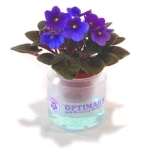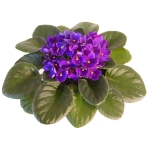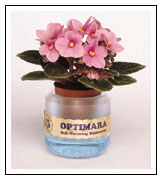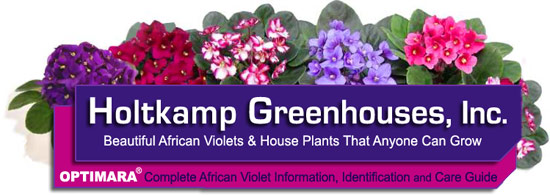| |
When Optimara Violets were first introduced in 1977, they represented
the crowning achievement not only for Holtkamp Greenhouses (the developer
of Optimara Violets), but for the African Violet industry as a whole. Beyond
the obvious quality of their large, colorful blooms, Optimara Violets were
the embodiment of nearly 50 years of research and development at Holtkamp
Greenhouses.
Holtkamp Greenhouses: The Years Before Optimara
 While the botanical history of African Violets (genus Saintpaulia) goes
back to 1892, it was not until the late 1920s and 30s that research and
development efforts began to yield those characteristics for which today's
African Violets are recognized. Instrumental to these efforts was the work
of Hermann Holtkamp, Sr., whose legacy would literally shape the growth of commercial African
Violets. Through him, and the next generation of Holtkamps, came many innovations
which, today, are often taken for granted. While the botanical history of African Violets (genus Saintpaulia) goes
back to 1892, it was not until the late 1920s and 30s that research and
development efforts began to yield those characteristics for which today's
African Violets are recognized. Instrumental to these efforts was the work
of Hermann Holtkamp, Sr., whose legacy would literally shape the growth of commercial African
Violets. Through him, and the next generation of Holtkamps, came many innovations
which, today, are often taken for granted.
Among the innovations contributed
by Holtkamp Greenhouses are non-dropping flowers, continuous blooming and
the single-crowned, Biedermeier-style of commercial propagation.The first Holtkamp variety was named "Saint Martin" in honor
of Holtkamp's father-in-law, Martin Dorrenbach. In 1956, Holtkamp introduced
the Rhapsodie trademark. It was under this name that the characteristic
of non-dropping flowers made its historic debut. Prior to the development
of this characteristic, in 1965, even the slightest movement might cause
African Violets to loose or "drop" their flowers. Needless to
say, this made shipping African Violets extremely difficult. The introduction
of non-dropping flowers was, therefore, heralded as a key milestone in the
growth of the commercial African Violet sector. Non-dropping flowers are
now standard for all commercial growers.
From the mid-1960s until 1977, when the Optimara trademark was introduced,
the development of non-dropping flowers was undoubtedly the most significant
contribution to the industry. However, it was far from being Holtkamp's
only contribution. During this same period, Holtkamp Greenhouses underwent
a surge of growth, spurring the industry as a whole to grow with them. Worldwide
sales were more than doubling every four years. To a considerable extent,
this was due to the untiring work being conducted at Holtkamp's research
and development facility, which was generating many new characteristics
that would make African Violets not only more beautiful, but easier to grow.
 Optimara: A Breakthrough for African Violets Optimara: A Breakthrough for African Violets
Prior to the 1970s, Holtkamp Greenhouses had a presence in the United
States only through its licensed propagators which grew and marketed African
Violets under the Rhapsodie trademark. All this changed, however, when Reinhold
Holtkamp, the son of Hermann Holtkamp, Sr., set up operations in Nashville,
Tennessee. Soon after, Reinhold introduced an entirely new trademark of
African Violets. Barely a decade later, this trademark would represent the
most recognized name of African Violets in the world. This trademark is,
of course, "Optimara."Introduced in 1977, the Optimara name is derived from two words: optimum
(meaning the best) and Usambara (the mountains in East Africa where the
African Violet was first discovered).
From the beginning, Holtkamp Greenhouses
USA set out to make Optimara Violets as easy to grow as they were beautiful.
To do this, Reinhold Holtkamp did two things. First, he set up a new R&D
facility which, while working in cooperation with R&D in Germany, could
also move in new directions. Second, he began to develop a full line of
plant care products designed specifically for African Violets.With the blessing of nearly 50 years of African Violet research for its
foundation, the new R&D facility, at Holtkamp Greenhouses USA, began
work with an undeniable advantage. Nevertheless, Optimara could never have
grown as rapidly as it did without the good instincts and untiring efforts
of its president and chief researcher, Reinhold Holtkamp, Sr. In an age
when corporate heads are rarely found beyond the safety and comfort of their
offices, Reinhold was literally getting his hands dirty (which he still
does). As a result, Optimara soon had over 100 new varieties and, beginning
in 1986, was able to debut its miniature "Little Indian" series
and super miniature "Little Jewel" series.
During this same period,
Optimara began crossing all their varieties with an extraordinary, new characteristic
called semper-florescence, or continuous blooming. As the name suggests,
this characteristic gives Optimara Violets the ability to bloom non-stop.Perhaps one of the most exciting projects, originating from Holtkamp's
research and development in Nashville, is the "Space Violet" program.
Optimara & NASA: Space Violet Experiments Yeild Stunning Results
 In 1984, Holtkamp Greenhouses launched 25,000 Optimara seeds into space
on one of NASA's space shuttles. The seeds remained in space, orbiting the
Earth, for nearly six years. (The Long Duration Exposure Facility, on which
the seeds orbited, is shown at right.) The program was conceived to test
the effect of long-term
exposure to cosmic radiation and lack of gravity. When the seeds were retrieved
in 1990, many mutations soon became apparent. While most of these mutations
are still being developed, some have already been crossed with Optimara
varieties. In 1984, Holtkamp Greenhouses launched 25,000 Optimara seeds into space
on one of NASA's space shuttles. The seeds remained in space, orbiting the
Earth, for nearly six years. (The Long Duration Exposure Facility, on which
the seeds orbited, is shown at right.) The program was conceived to test
the effect of long-term
exposure to cosmic radiation and lack of gravity. When the seeds were retrieved
in 1990, many mutations soon became apparent. While most of these mutations
are still being developed, some have already been crossed with Optimara
varieties.
One such mutation has resulted in a new characteristic called
multiflorescence. This characteristic gives Optimara Violets an extraordinary
abundance of flowers which never stop blooming. Compared with PMA standards,
which define a finished African Violet as having five to seven open blooms,
a multiflorescent Optimara variety will have at least 20 open blooms.
Aside from the Space Violet program, some of Optimara's more exciting projects
include the introduction of many new series. Among these are the World Traveler
series, the Victorian Charm series, and the Artist's Palette series. The World
Traveler series is comprised of extra large, 6-inch Violets which are named
for major cities around the world. The Victorian Charm series features a number
of standard, 4-inch Violets with variegated leaves. Each variety in this series
is named for a virtue reminiscent of the Victorian era. The Artist's Palette
series features standard, 4-inch Violets which are characterized by large flowers
with splashes of color. Each variety in this series is named for a famous painter.
Optimara: Beautiful African Violets That Anyone Can Grow
 While work in Holtkamp's R&D-Nashville has continued to make Optimara
Violets ever more beautiful, it has also made them easier to grow by isolating
those traits which would make Optimara Violets grow faster and more resistant
to environmental stresses such as temperature variations and improper cultural
practices. While such characteristics are not always as readily visible
as an Optimara Violet's big, colorful blooms, they are nonetheless integral
to what makes an Optimara Violet "simply" beautiful. With this
in mind, the development of Optimara plant care products was really just
an extension of what Holtkamp Greenhouses has always sought to do in their
hybridizing efforts.Beginning in the 1980s, Optimara began to introduce a line of plant care
products specifically designed for African Violets. Because of the special
needs of African Violets, the development of Optimara plant care products
was viewed as an important contribution to the industry. With more than
half a century of research to guide them, Optimara was in an unique position
to develop products that would make it easy for anyone to grow beautiful
African Violets. While work in Holtkamp's R&D-Nashville has continued to make Optimara
Violets ever more beautiful, it has also made them easier to grow by isolating
those traits which would make Optimara Violets grow faster and more resistant
to environmental stresses such as temperature variations and improper cultural
practices. While such characteristics are not always as readily visible
as an Optimara Violet's big, colorful blooms, they are nonetheless integral
to what makes an Optimara Violet "simply" beautiful. With this
in mind, the development of Optimara plant care products was really just
an extension of what Holtkamp Greenhouses has always sought to do in their
hybridizing efforts.Beginning in the 1980s, Optimara began to introduce a line of plant care
products specifically designed for African Violets. Because of the special
needs of African Violets, the development of Optimara plant care products
was viewed as an important contribution to the industry. With more than
half a century of research to guide them, Optimara was in an unique position
to develop products that would make it easy for anyone to grow beautiful
African Violets.
Among the most important products which Optimara developed
was a Violet Food with a precisely balanced formulation to produce full-blooming
African Violets with vigorous roots and strong, green foliage. The 14-12-14
NPK was derived from years of analyzing the growth and performance of African
Violets at Holtkamp Greenhouses, where the same formulation continues to
be used. While cheaper sources of nutrients were available, Optimara chose
higher grade sources in order to eliminate harmful impurities, such as urea,
which is known to cause Root Burn on African Violets.
Another important plant care product which Optimara introduced was their
potting soil. Because it is often thought of as nothing more than dirt,
the importance of a good potting medium is frequently underestimated. Perhaps
this is because many potting soils marketed for African Violets are, in
fact, nothing more than dirt. Such potting soils, however, can be extremely
harmful to African Violets. Because they tend to be heavy and hold too much
water, they can literally crush the tender roots of African Violets and
leave the plant susceptible to such deadly pathogens as Root Rot and Crown
Rot. In addition, many potting soils are often too acidic, thereby stifling
an African Violet's ability to absorb nutrients. For these reasons, Optimara
developed a soilless potting medium comprised of block-harvested, sphagnum
peat moss. To this, a small amount of calcium carbonate was added to adjust
the pH to the proper range of 5.8 to 6.2. As a result, Optimara Potting
Soil provides African Violets with an ultralight medium that encourages
the proper absorption of water and nutrients.
Some of the most popular items in the Optimara plant care line are the
many innovative self-watering devices. Each of these devices uses the phenomenon of capillary action to
draw just the right amount of water into the soil. This greatly reduces
any chance of either underwatering or overwatering. One such device is the
Optimara Watermaid.
The Watermaid stores water in a saucer from which it
is drawn into the soil via capillary matting. The Watermaid gives African
Violet growers a measure of versatility by accommodating pot sizes up to
5-1/2 inches. Other Optimara self-watering devices use capillary wicking
to draw water from an enclosed well. These include the Optimara MiniWell,
for 1-inch super miniature varieties, and the Optimara MaxiWell, for 4-inch
standard varieties. The latest self-watering innovation from Optimara is
the Optimara WaterShip container for 2-inch miniatures (shown at right).
The WaterShip container is not only self-watering, but spill-proof. This
feature allows Optimara Miniatures to be shipped with water.
Optimara: The Future of the World's Most Popular House Plant
In a world which has known so many great songs, it can sometimes be tempting
to believe that there are none left to be written. And yet, there always
seems to be one more to add to the list. So it is with Optimara.Among the future hits that Optimara is working on are the development of a
yellow and true red (or crimson) African Violet. Both have eluded the best efforts
of researchers for years, and the development of either one would represent
a monumental achievement. About every other year, rumors surface that someone
has finally done it.
However, all of these rumors have either proven unreliable
or have been based on very limited successes. A true yellow or red African Violet
will only be achieved when such a variety has been stabilized over a period
of three or more generations. While such an achievement will be years in the
making, it is one which Optimara hopes to accomplish in the near future.In the meantime, the
Space Violet program is still providing new discoveries which promise to
enhance Optimara Violets in a number of ways. Some of the new characteristics
discovered will make Optimara Violets more resistant to injury and other
sources of trauma. Other characteristics will contribute to the aesthetic
value of Optimara Violets.
 Whatever the future holds for Optimara, it is sure to bring something
new and exciting to the world of African Violets. As it was in the early
years of Holtkamp Greenhouses, everything that Optimara does, now, is setting
the foundation for whatever breakthrough comes next. And even if nothing
else is certain, we at least know that someone at Optimara will be getting
their hands dirty. After all, the future of Optimara is not set in stone.
It is, in fact, set in about 12 ounces of potting soil precisely formulated
and pH balanced for the most popular house plant in the world. Whatever the future holds for Optimara, it is sure to bring something
new and exciting to the world of African Violets. As it was in the early
years of Holtkamp Greenhouses, everything that Optimara does, now, is setting
the foundation for whatever breakthrough comes next. And even if nothing
else is certain, we at least know that someone at Optimara will be getting
their hands dirty. After all, the future of Optimara is not set in stone.
It is, in fact, set in about 12 ounces of potting soil precisely formulated
and pH balanced for the most popular house plant in the world.


To order any of the products discussed on this page,
visit
Selective Gardener

Copyright 1999-2002 Optimara/Holtkamp Greenhouses, Inc.
Nashville, Tennessee. Doctor Optimara, the Doctor Optimara logo and Optimara
Field Guide are trademarks of Holtkamp Greenhouses, Inc. Optimara, the Optimara
logo, EverFloris, MiniWell, MaxiWell, WaterShip and Watermaid are trademarks
of International Plant Breeding, A.G., Switzerland.
|




